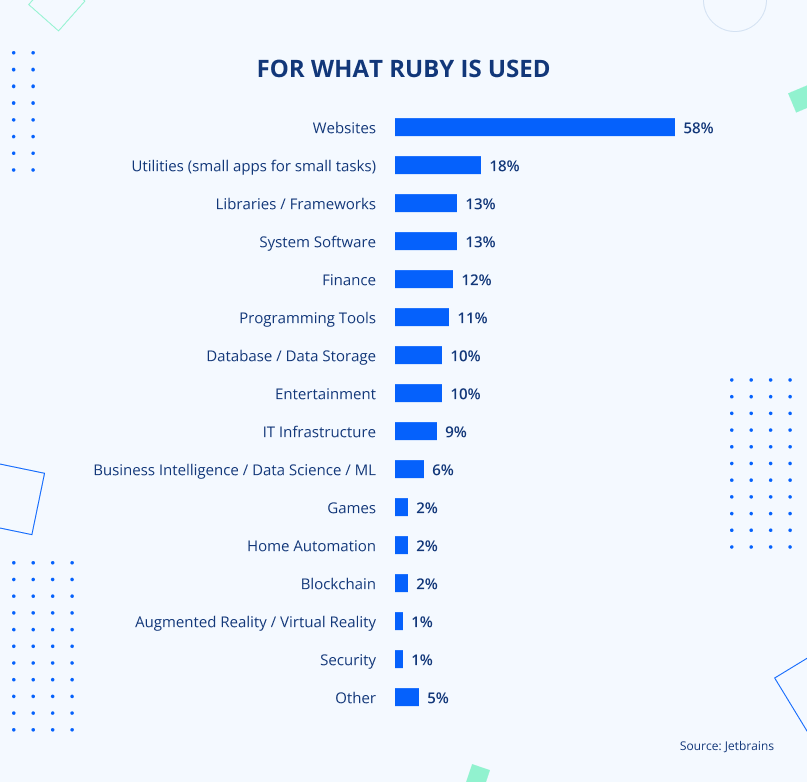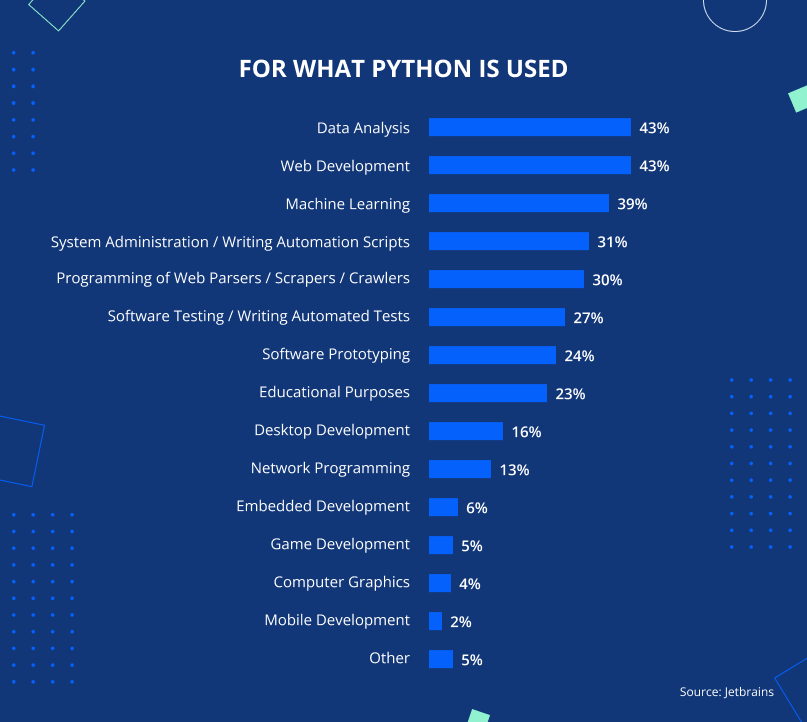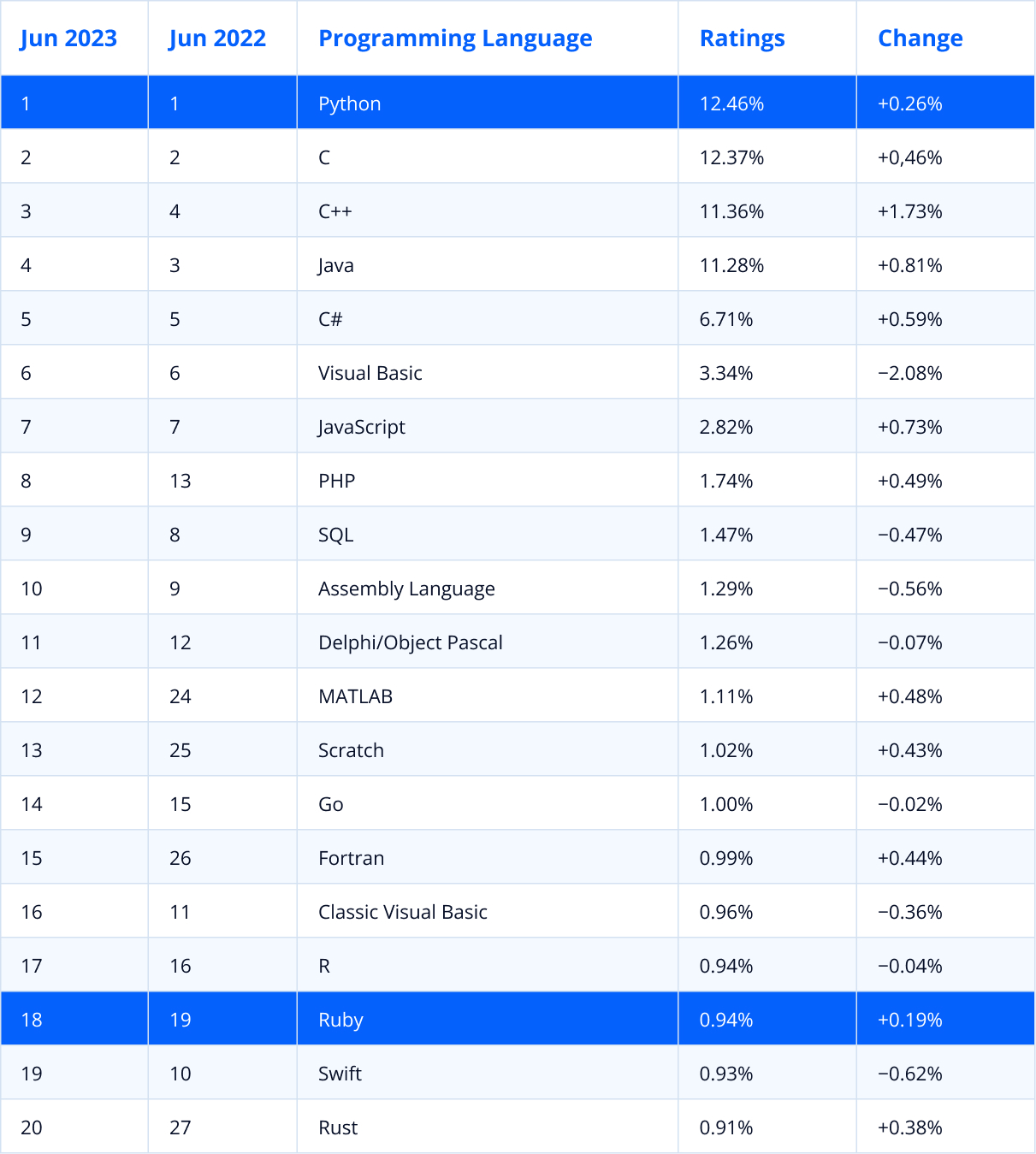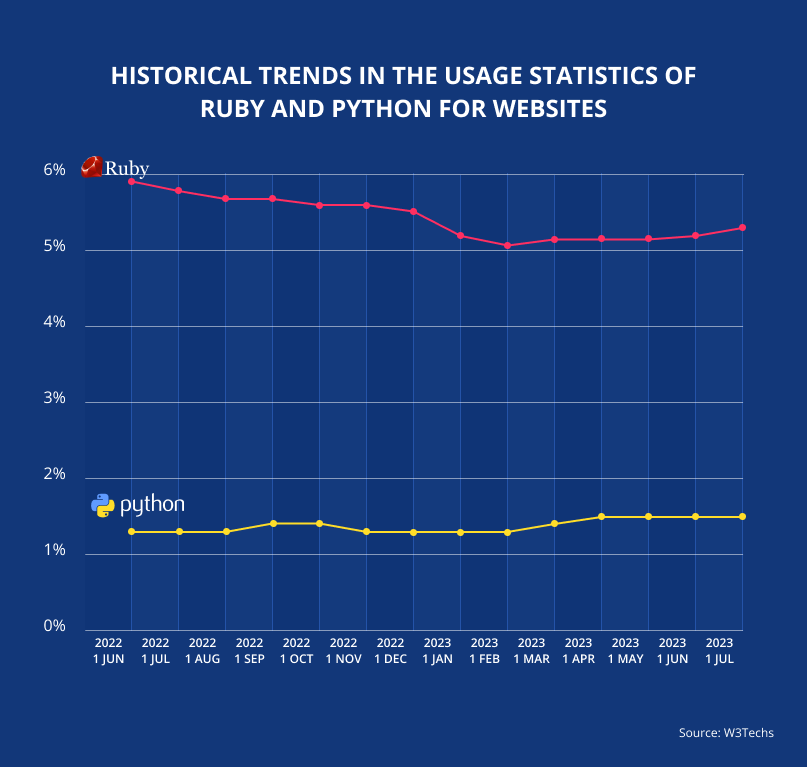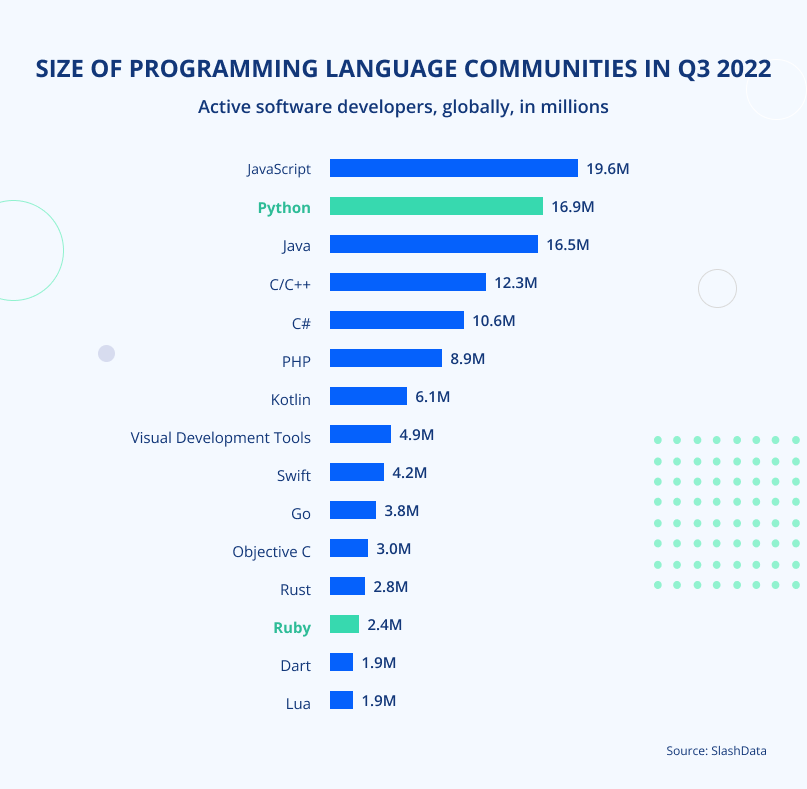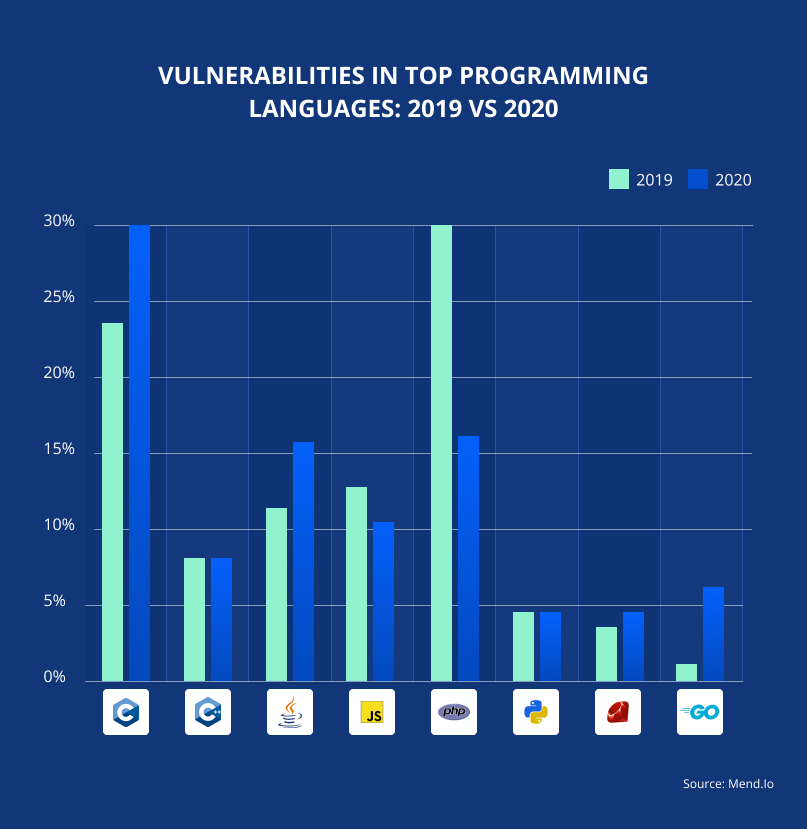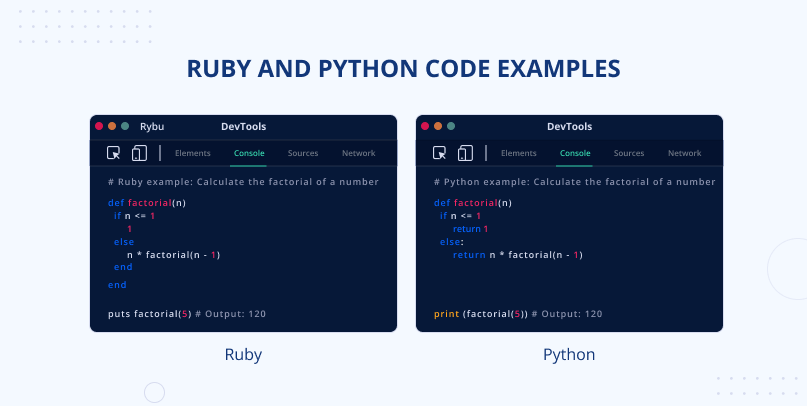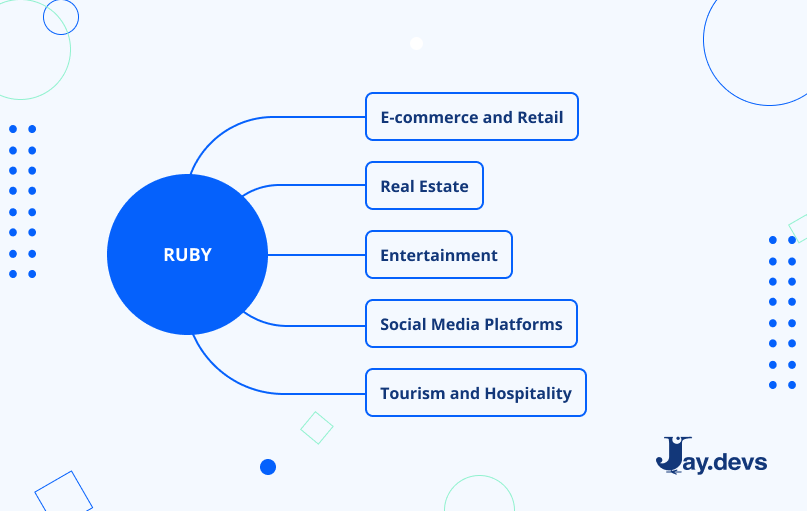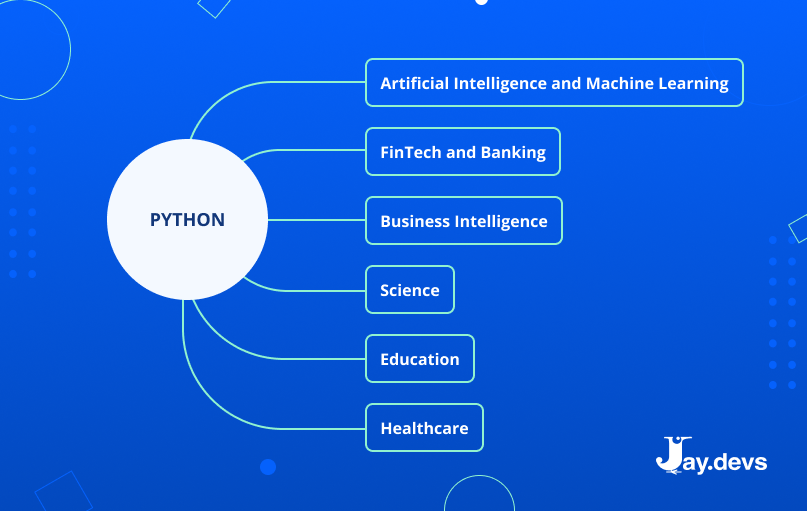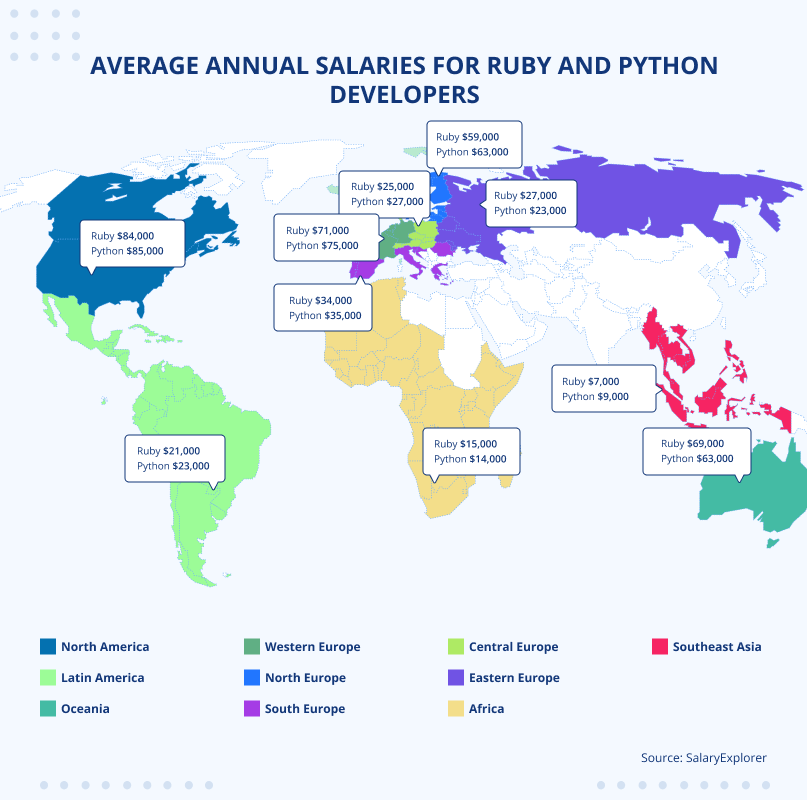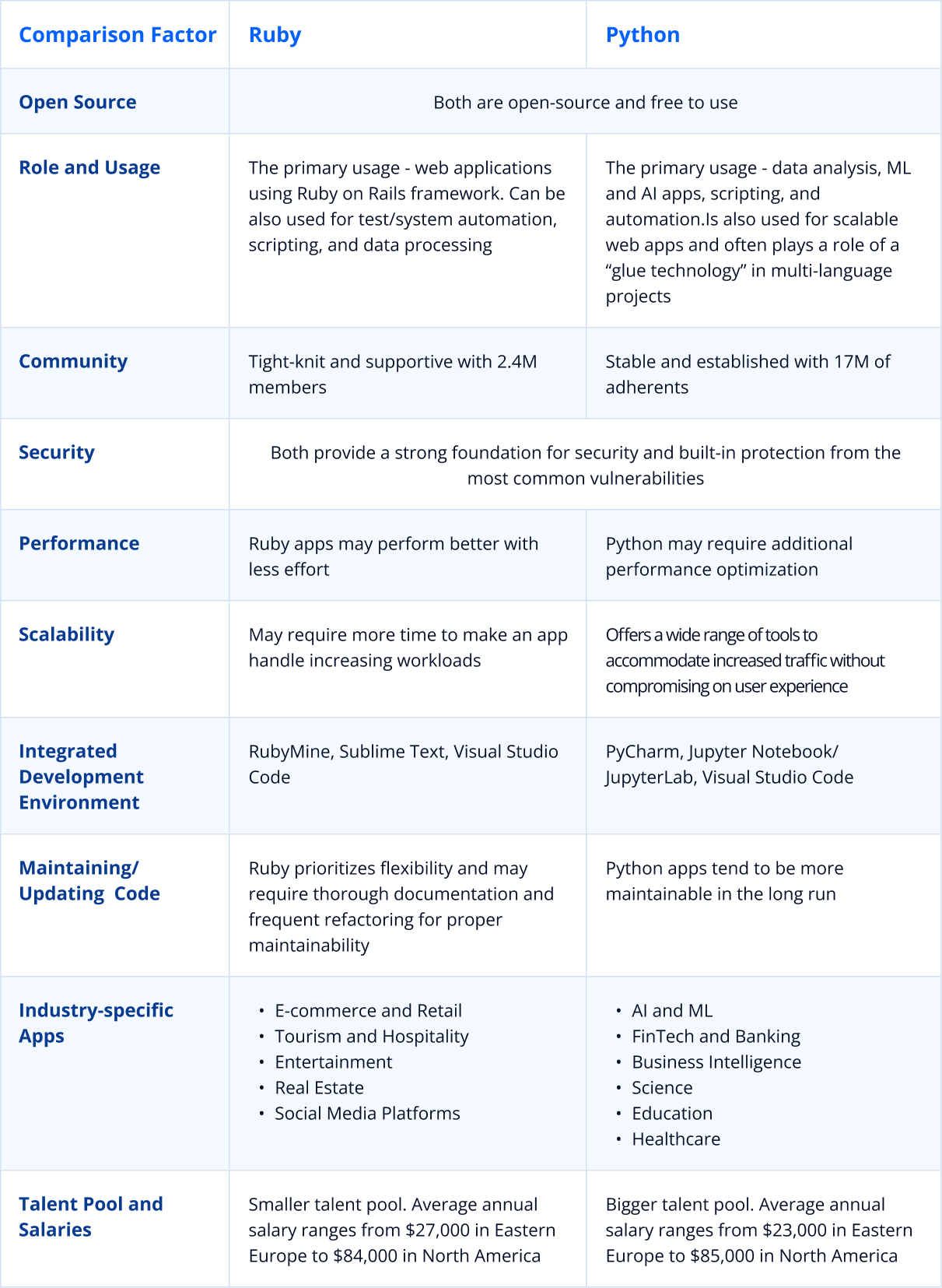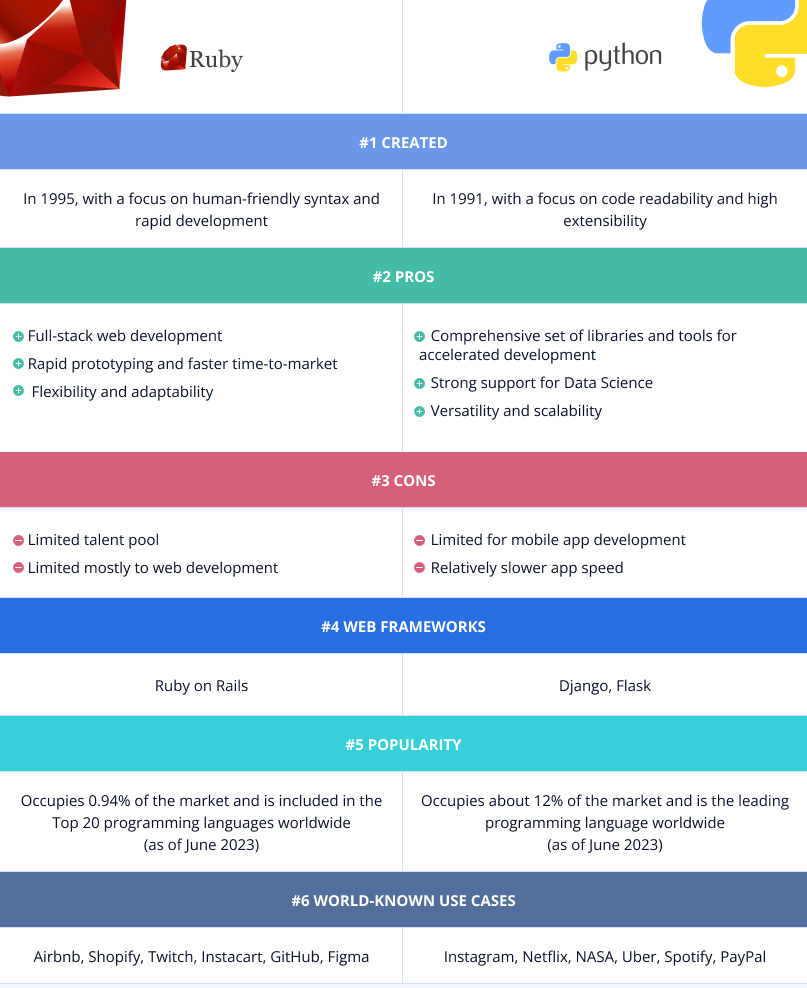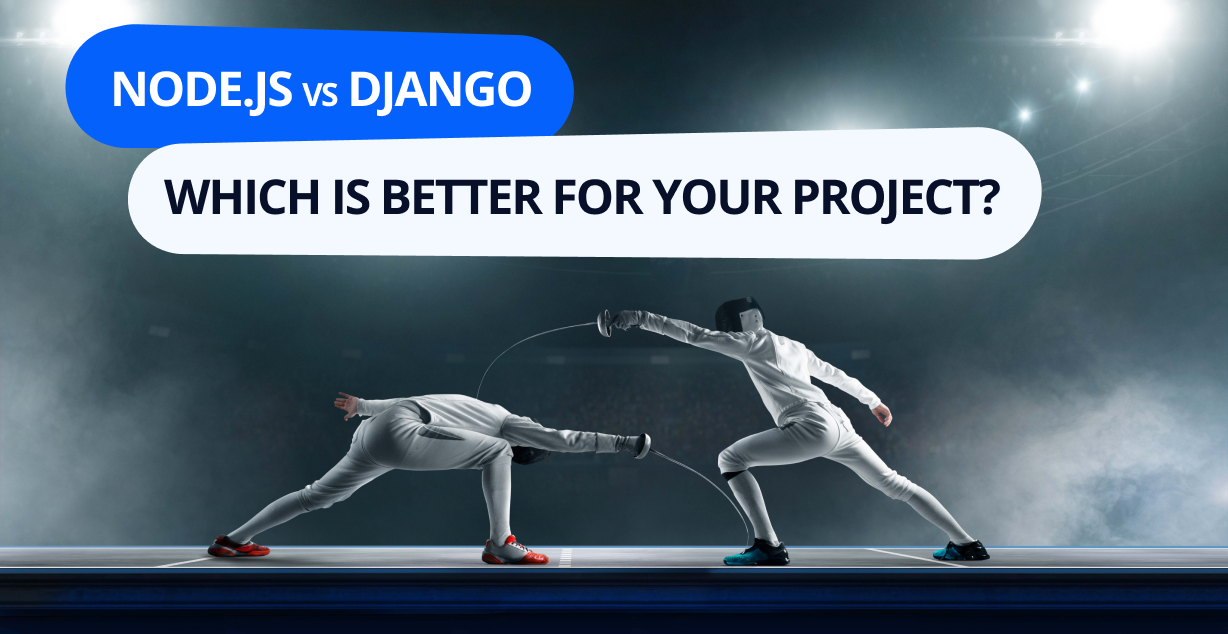Within the dynamic realm of software development, two powerhouses reign popular: Ruby and Python programming languages. In fact, these versatile languages have become go-to tools for web development and beyond.
Whether you are about to kickstart a new software product or seeking to scale your existing projects, understanding the nuances of these languages is essential in shaping the trajectory of your endeavors. Additionally, it plays a vital role in making informed decisions when hiring the right talent for your team.
Accordingly, the following article aims to simplify the Ruby vs Python comparison, thereby shedding light on their unique attributes and helping you determine which language will best power your projects. Through a head-to-head showdown, we will explore the strengths and applicability of each language, assisting you in selecting the technology that aligns with your specific business objectives.
Ruby vs Python: What is Ruby?
Ruby is a general-purpose, object-oriented programming language created in the mid-1990s by Yukihiro Matsumoto. Inspired by other programming languages, like Perl and Smalltalk, Ruby was publicly released in 1995 with a priority on flexibility and productivity.
Ruby language encourages human-friendly syntax and rapid development, being a foremost choice for building web applications. Notably, the Ruby on Rails web framework has played a significant role in Ruby’s adoption for web development projects.
Apart from that, Ruby can be used for building automation scripts, development tools, data processing solutions, and more.
Ruby Features
- Object-Oriented Language: Ruby follows a pure object-oriented programming paradigm, enhancing code organization and reusability for creating sophisticated solutions.
- Expressive Syntax: Ruby’s syntax resembles natural English, enabling developers to write flexible code.
- Full-Stack Web Development: The Ruby on Rails framework allows for frontend and backend development, ensuring application consistency.
- Metaprogramming: Ruby enables writing code that can modify itself or other parts of the program during runtime, leading to highly customizable applications.
Advantages of Ruby
- Faster Time-to-market: Expressive syntax and code reusability contribute to faster development cycles, thus benefiting startups and established companies.
- Budget-friendly: Ruby on Rails reduces the need for multiple developers or teams, allowing businesses to hire full-stack developers exclusively, thereby cutting costs.
- Flexibility and Adaptability: Ruby’s dynamic nature and metaprogramming capabilities enable businesses to adapt and modify their software as requirements evolve.
Disadvantages of Ruby
- Limited Talent Pool: Finding experienced Ruby developers may be challenging compared to more mainstream languages like Python or JavaScript.
- Limited Applicability: Ruby is primarily suitable for web development and may have less potential for other solutions.
Ruby vs Python: What is Python?
Python is a versatile, high-level programming language known for its simplicity and code readability. Created by Guido van Rossum and first released in 1991, Python was designed to be highly extensible.
Python programming language has a wide range of applications beyond web development. It is widely used in data analysis, machine learning, artificial intelligence, automation tasks, and more.
Python offers frameworks like Django and Flask for web development. Like Ruby on Rails, Django enables rapid development of complex web applications, while Flask provides a lightweight and flexible framework for smaller projects.
Python Features
- Readability: Comparing the syntax of Ruby vs Python, both are easy to read, yet Python is more explicit, making it more maintainable.
- “Batteries Included” Language: Python offers a comprehensive standard library and many third-party packages for accelerating development.
- Mixed Programming: Python doesn’t enforce strict object-oriented programming, allowing developers to combine it with procedural or functional code for specific use cases.
- Easy Integration: Python seamlessly interoperates with Java, C++, and other languages being a choice for multi-language systems.
Advantages of Python
- Rapid Development: Python’s extensive ecosystem of modules and packages for common functionalities saves time for “reinventing the wheel.”
- Versatility: Python enables businesses to tackle a wide range of tasks and projects, offering cost-effectiveness for businesses.
- Strong Support for Data Science: Python libraries like NumPy, SciPy, and TensorFlow make it a silver bullet for machine learning, AI, and data-driven solutions.
- Scalability: Python allows businesses to start small and grow their projects effectively without major architectural changes.
Disadvantages of Python
- Performance Limitations: Python has a relatively slower app speed than Java or C++.
- Limited for Mobile Development: Python is not optimized for mobile apps, which can be a drawback in commercial usage scenarios.
Ruby vs Python: Similarities
Apart from their distinct features, both Python and Ruby share common characteristics. These similarities between Ruby and Python include the following:
- Open Source: Both technologies are free to use, enabling engineers to contribute improvements and bug fixes to the language.
- Server-side Programming: Each technology is created as a server-side scripting language, primarily used for backend development.
- High-level Languages: These two languages are portable and independent of the specific hardware and processors.
- Interpreted Languages: The code of both languages is interpreted at runtime without a compilation step, promoting faster development.
- Dynamic Typing: Both tools allow developers to work with flexible variable data types, promoting agile development.
- Cross-platform: Python and Ruby apps can function across multiple operating systems, such as Windows, macOS, and Linux.
- Multi-paradigm: Both technologies are object-oriented languages supporting procedural, reflective, and functional programming paradigms for increased flexibility.
- Web Frameworks: Ruby on Rails and Django are powerful web frameworks for building scalable web apps. Each web framework supports MVC architecture: it separates business logic, user interface, and layout, leading to organized and maintainable app structures.
Ruby vs Python: Side-by-Side Comparison
Now that you know the basic features, specifics, and similarities, let’s examine the difference between Ruby and Python. Below we’ll discuss their popularity, use cases, hiring opportunities, and more to help you decide whether the Ruby language vs Python is right for you.
Which One Do Businesses Prefer?
Firstly, examining market share and usage statistics is essential to determine which language is preferred.
According to TIOBE, Ruby comprises only 0.94% of the market, being the 18th among the Top 20 technologies used worldwide.
Conversely, Python language occupies about 12% of the global market. Since 2013, it has risen in ratings from 8th to 1st place among other languages due to the continuous growth of AI:
The situation is different when comparing Ruby vs Python for web development, especially for websites. W3Techs reports that about 5.3% of websites are built with Ruby, while only 1.5% leverage Python:
Another way to establish demand for Python versus Ruby is the number of job postings. For instance, Indeed provides more than 74K jobs for Python specialists (such as backend engineers and data science specialists). For Ruby devs, there are about 3K job offerings (primarily for Ruby on Rails specialists).
Such contrasting popularity of Ruby vs Python proves that businesses prefer Ruby for web projects, while Python’s versatility is a top choice for other areas.
The Role of Python and Ruby in Software Development
Python and Ruby are used for app development and for automating and optimizing DevOps processes.
Specifically, they allow for writing scripts that streamline tasks like building, deployment, and infrastructure management. Tools like GitLab, Jenkins, and Ansible support Python and Ruby scripts without a hassle, thereby ensuring continuous development even with distributed project teams.
The core difference between Python and Ruby roles within projects is that Python excels at integrating with other programming languages. It acts like a “glue language,” integrating C++, Java, Go, and similar technologies. It is particularly valuable for microservice architecture, where separate app “services” can be built with diverse technologies.
The Importance of Community and Support in Python and Ruby
A strong community and support network are crucial when using any technology to build a project. Therefore, the larger the community, the more efficient project development can be. With a vibrant community, engineers can:
- Tap into the collective expertise through online forums, discussion boards, and community-driven websites to solve coding challenges,
- Leverage open-source libraries to enhance app capabilities and accelerate development,
- Remain updated with the latest advancements and produce innovative solutions.
Moreover, the community can serve as a talent pool. Engaging with the community through meetups or online resources may help business owners find industry professionals and augment their development team with skilled talents.
The Ruby community consists of about 2.4M passionate developers. It offers a tight-knit and supportive environment and high-quality documentation, helpful for proper project implementation.
In the context of a community, Python excels compared to most other technologies, as it boasts around 17M adherents. It provides plenty of learning resources, as well as ready-to-use tools:
Being smaller in scale, Ruby cannot boast such a huge number of libraries, packages, and skilled professionals as Python. In this sense, Python is a clear winner here, having a more mature and extensive network.
Security Considerations
Python and Ruby provide a strong foundation for security and protection from the most common vulnerabilities, such as cross-site scripting, input validation, access control, and more.
They are considered among the more secure technologies available. In 2020, they accounted for approximately 6% and 5% of the total software vulnerabilities reported, respectively:
However, they are not immune to security concerns. To ensure protection from unauthorized access or data leaks, organizations and dev teams should stay updated with security patches, follow secure coding practices, and conduct regular security assessments.
Whether you choose Python or Ruby on Rails, it’s vital to incorporate security scanners and testing tools early in the development lifecycle.
Scalability and Performance of Python vs Ruby
Scalability and performance are critical considerations that allow businesses to accommodate increased traffic without compromising the user experience.
Ruby is often perceived as having fewer helpful tools for scalability-related tasks. As a result, developers may require more time to make a web app that can handle increasing workloads. However, Ruby’s runtime performance is generally twice as fast, as indicated by the Ruby vs Python benchmark.
Conversely, Python provides a wide range of tools for horizontal scaling, load balancing, and caching. This rich set of resources enables businesses to handle increasing traffic more effectively.
When comparing Python vs Ruby speed and scalability, think of your priorities first. While Ruby can be well-suited for small or medium-sized apps prioritizing responsiveness, Python can be more effective for projects requiring stellar scalability.
Choosing the Right IDE for Ruby or Python Development
Consider cost, features, and support when choosing an Integrated Development Environment for Ruby programming language vs Python.
Popular IDEs for Ruby development include RubyMine (paid, feature-rich), Visual Studio Code with Ruby extensions (free, versatile), and Sublime Text with appropriate plugins (paid, lightweight).
Widespread options for Python include PyCharm (free and paid editions, feature-rich), Visual Studio Code with Python extensions (free, customizable), and Jupyter Notebook/JupyterLab (free, data-centric).
Ultimately, the choice depends on engineers’ preferences, project requirements, and workflow.
Testing Python and Ruby Code
Both languages provide robust testing frameworks — RSpec and Pytest. However, there are differences in the syntax of Python vs Ruby that can affect the process.
Ruby’s flexibility and expressive syntax facilitate code experimentation but can make testing for errors more challenging. Thus, Ruby code may require additional time to debug.
Python, with its readable syntax, supports writing testable code. It reduces the time needed to identify and address errors.
In summary, testing Ruby databases and software may be resource-intensive, while Python apps may be relatively faster to test.
Maintaining and Updating Python and Ruby Code
Maintaining and updating code is an ongoing process. Developers must remain updated with the latest stable technology versions, conduct thorough testing, and implement performance improvements.
Ruby is known for its focus on cutting-edge flexibility and fast development lifecycles, prioritizing rapid prototyping and productivity over strict maintainability.
In contrast, Python’s focus on readability and adherence to the best practices make it easier for developers to understand and modify code.
As a result, Python apps tend to be more maintainable in the long run, ensuring software stability. To improve maintainability for Ruby solutions, businesses should emphasize clear documentation, consistent coding standards, and frequent refactoring.
Code Quality in Python and Ruby
Like many programming languages, Python and Ruby prioritize code quality.
Nonetheless, Ruby promotes enjoyable coding experiences, while Python focuses on consistency. Some may assume that Python code is generally of more integrity.
Here are the code examples of Ruby vs Python for comparison:
Regardless of whether you choose Ruby on Rails or Python, the code quality ultimately depends on the developer’s discipline, adherence to best practices, and code review processes within the team.
Case Studies: Ruby vs. Python in Real-World Projects
Comparing Ruby versus Python in projects reveals their strengths and particular applicability.
Here are a few case studies showcasing Ruby usage:
- Airbnb: An online marketplace for accommodations, moved its web platform from PHP to Ruby on Rails, thus benefiting from a speedy development cycle.
- Shopify: A worldwide Software-as-a-Service e-commerce platform leveraged RoR to provide its users with a highly performant and stable solution.
- Twitch: A popular streaming platform leveraged Ruby to rapidly develop their monolithic architecture using “state-of-the-art coding practices.”
Comparing the usage of Python vs Ruby on Rails, the former is powering:
- Instagram: A leading social media platform that relies on the Python web framework, Django for its scalability and security. It helped to manage a massive user base and complex operations.
- Netflix: The giant among streaming services uses Python for data science and machine learning (analyzing user viewing history, forecast audience size, and recommendation algorithms).
- NASA: One of the earliest adopters, NASA uses Python as one of the most straightforward technologies for data science and scientific computing.
Industry-Specific Applications
Ruby, with its emphasis on rapid prototyping and ease of use, is widely used for web app development in sectors like:
Python’s versatility and strong focus on data science give it an edge in fields like:
Hiring Ruby Developers vs. Hiring Python Developers
As mentioned, Python has a larger community, making it easier to find Python developers for your project.
While Ruby’s popularity may lower, there is still a considerable pool of web developers specializing in Ruby on Rails.
This difference in popularity and demand between Ruby on Rails vs Python influences developers’ salaries, which vary depending on the region. To help you plan your hiring strategies, here is a rough comparison of salaries for Ruby engineers and Python programmers:
The Future of Ruby and Python: Trends and Predictions
The future of Ruby vs Python in 2024 and beyond in the context of business and technology seems ambiguous.
While Ruby’s popularity is dropping gradually, it remains a choice for web app development, giving the edge of speed to startups and growing businesses.
On the flip side, Python is a leader in data science and machine learning fields, which are snowbowling globally. Furthermore, Ruby’s speed of new releases demonstrates how Python is more frequently updated, ensuring its continuous adaptability to the market.
Considering these factors, Python will most likely keep thriving in its dominance in the emerging fields, while Ruby’s significance will persist in the web development landscape.
To summarize the core differences between Ruby vs Python, here is a table wrap-up:
When Is the Use of Ruby Recommended?
Now that you know that Ruby is perfect for creating web applications, here are some scenarios where it is especially efficient:
- Prototyping and MVP development to test the hypothesis,
- Full-stack web development for startups and smaller teams,
- Commercial, medium-sized apps.
When Is the Use of Python Recommended?
Python is a great option for:
- Projects involving Data Science, Machine Learning, and Artificial Intelligence,
- Scalable web apps using the most popular Python framework — Django,
- Projects requiring system automation and scripting,
- Projects involving multiple languages and microservice architecture.
Conclusion
If you are at a crossroads wondering, “Ruby vs Python, which is better?” it’s vital to determine your project’s specific requirements and priorities.
Ruby shines in web application development, offering quick prototyping, full-stack development, and high cost-efficiency for commercial projects.
With Python, you can unlock a wide range of possibilities, from incorporating machine learning algorithms into current solutions to automation of DevOps practices within projects.
Whichever you choose, you should carefully approach the issue of hiring skilled programmers. If you lack in-house talents, you can consider hiring remote developers as one of the most flexible and budget-friendly alternatives. By reaching out to JayDevs, you can quickly hire Python developers or Ruby professionals who are pre-screened and specialized in various domains!





